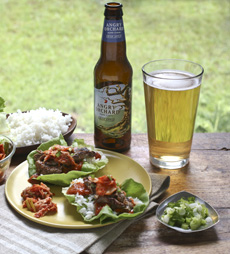TIP OF THE DAY: Cider Tasting For Mother’s Day
 Drier ciders work better with meats. Photo courtesy Angry Orchard. |
Skip the Pinot Grigio and taste some cider for Mother’s Day. It’s more novel than wine, and will suit any guest:
Cider is equally popular among men and women, whereas beer is significantly more popular among men*. Cider is also gluten-free and less filling than beer. While many people think “autumn” when they hear “cider,” that is true for non-alcoholic cider, which is fresh-pressed. Hard cider is fermented for eight weeks after the juice is pressed. The cider then matures for several months, is blended, filtered and carbonated. So the “freshest” hard cider is on the market now, not in the fall. Another note: In the U.S., alcoholic cider is called hard cider and apple cider/apple juice (the terms are interchangeable in the U.S.) is simply called cider. In the U.K. it’s the reverse: “Cider” is hard cider. While most cider is made from apples, you’ll also find pear cider, known in the U.K. as perry. |
|
|
CIDER & FOOD PAIRINGS Hard ciders pairs with the same foods as beer and white wine. Styles range from very dry to sweet “hard apple juice.” |
||
|
CIDER TASTING PARTY: WHERE TO START
1. Gather up a dozen brands or so, and invite friends over for a hard cider tasting. You’ll find hard ciders from the U.S. and England†. Get apple cider for the kids. 2. For serious foodies, conduct a blind tasting. Serve them in order of alcohol content, lowest to highest. Either cover up the labels with paper (we used a removable glue stick) or place each one in a paper sandwich sack (the size of a take-out coffee bag, which you can get at the nearest deli [offer to pay for them and you’ll likely get them for free]). 3. Mark each label or bag with a number, and provide each person with a tasting notes sheet. If your group is accustomed to evaluating beer and wine, you can adapt this professional scoring sheet. We put all the descriptors in the left column of that sheet onto one piece of paper, with one for each guest. For notes, we made up a simple sheet with designated areas for rating ciders 1 through 12 (or however many ciders you’re serving) on a second sheet. You can also print out this Cider Tasting Wheel. |
 You can use any glass you like for cider; this one is popular in Europe. Photo courtesy Crispin Cider. |
|
|
4. Decide on the food and how many bottles of each cider you’ll need for your size crowd. 5. Start with small pours: An ounce each of 12 cider becomes 12 ounces in relatively short order. At the end of the comparison tasting, people can go back for more. 6. Provide “dump buckets” so participants can toss what they don’t like. These can be large tumblers or other vessels (we’ve used short vases!). 7. Have a great time. |
||


